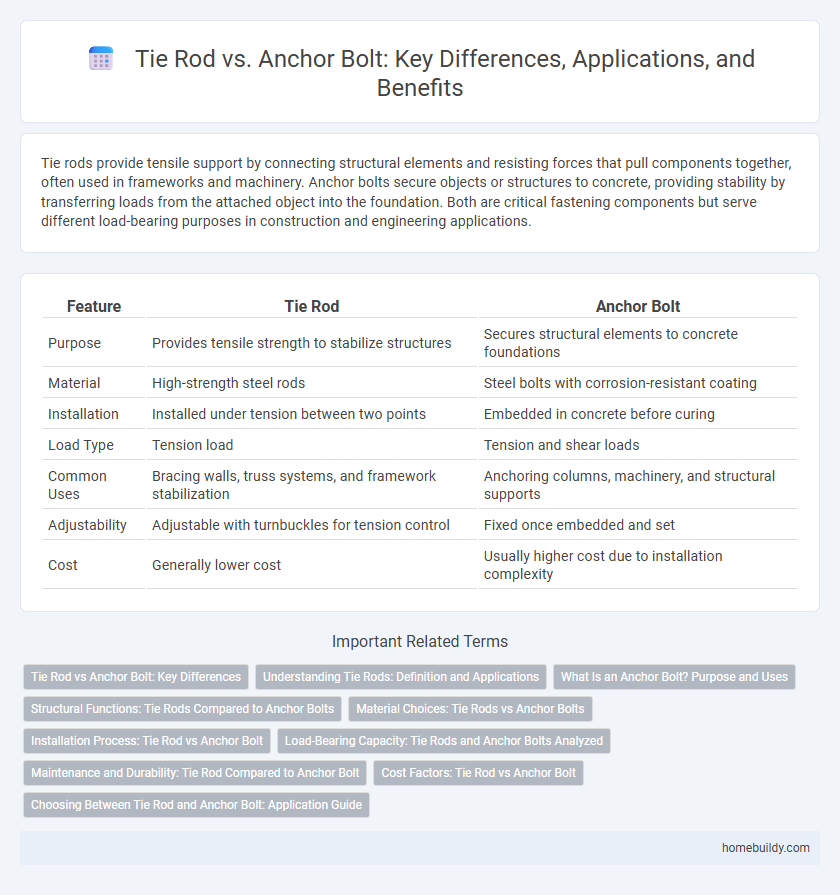Tie rods provide tensile support by connecting structural elements and resisting forces that pull components together, often used in frameworks and machinery. Anchor bolts secure objects or structures to concrete, providing stability by transferring loads from the attached object into the foundation. Both are critical fastening components but serve different load-bearing purposes in construction and engineering applications.
Table of Comparison
| Feature | Tie Rod | Anchor Bolt |
|---|---|---|
| Purpose | Provides tensile strength to stabilize structures | Secures structural elements to concrete foundations |
| Material | High-strength steel rods | Steel bolts with corrosion-resistant coating |
| Installation | Installed under tension between two points | Embedded in concrete before curing |
| Load Type | Tension load | Tension and shear loads |
| Common Uses | Bracing walls, truss systems, and framework stabilization | Anchoring columns, machinery, and structural supports |
| Adjustability | Adjustable with turnbuckles for tension control | Fixed once embedded and set |
| Cost | Generally lower cost | Usually higher cost due to installation complexity |
Tie Rod vs Anchor Bolt: Key Differences
Tie rods and anchor bolts serve distinct functions in construction; tie rods primarily provide tension support to hold structural elements together, while anchor bolts secure structures to concrete foundations. Tie rods typically resist tensile forces, stabilizing frameworks such as steel or wooden structures, whereas anchor bolts resist shear and tension forces to prevent lateral or uplift movement of equipment or columns. Understanding these key differences is essential for selecting the appropriate fastener based on load requirements and structural design.
Understanding Tie Rods: Definition and Applications
Tie rods are tension members used to stabilize structures by resisting tensile forces, commonly found in bridges, buildings, and machinery. Unlike anchor bolts, which primarily secure structures to foundations and resist shear and uplift forces, tie rods connect opposite ends to maintain structural integrity under tension. Their applications include reinforcing frameworks, aligning components, and preventing structural deformation.
What Is an Anchor Bolt? Purpose and Uses
An anchor bolt is a fastener used to attach structural elements to concrete, providing stability and resistance to shear and tension forces. It is commonly employed in securing machinery, steel columns, and wood framing to concrete foundations. Unlike tie rods that primarily handle tension within structures, anchor bolts ensure the firm anchoring of components to a solid base for structural integrity.
Structural Functions: Tie Rods Compared to Anchor Bolts
Tie rods primarily provide tensile strength by connecting structural components to resist tension forces, ensuring stability under dynamic loads. Anchor bolts secure structural elements to concrete foundations, offering resistance against shear and uplift forces through rigid attachment. While tie rods focus on maintaining alignment and tension within frameworks, anchor bolts anchor structures firmly to their base for overall load transfer and safety.
Material Choices: Tie Rods vs Anchor Bolts
Tie rods are commonly crafted from high-strength steel alloys such as carbon steel or stainless steel to provide tensile strength and corrosion resistance in structural applications. Anchor bolts are typically made from carbon steel, stainless steel, or galvanized steel to ensure durability and secure fastening in concrete foundations. Material selection for tie rods emphasizes tensile performance, whereas anchor bolts prioritize shear strength and corrosion protection in varying environmental conditions.
Installation Process: Tie Rod vs Anchor Bolt
Tie rods typically require precise alignment and tensioning during installation to ensure structural stability, involving insertion through pre-drilled holes followed by securing with nuts and washers. Anchor bolts are embedded in concrete before it sets, demanding accurate placement and curing time to achieve proper load transfer and hold. Both require specialized tools, but tie rods offer easier adjustability post-installation compared to the fixed positioning of anchor bolts.
Load-Bearing Capacity: Tie Rods and Anchor Bolts Analyzed
Tie rods provide superior tensile strength in structural applications, effectively resisting elongation under heavy loads, whereas anchor bolts excel in shear and pull-out resistance by securing components to concrete foundations. The load-bearing capacity of tie rods depends on their cross-sectional area and material grade, making them ideal for tension-dominant forces. In contrast, anchor bolts distribute loads through embedded concrete, offering enhanced stability against lateral forces but generally lower tensile capacity compared to tie rods.
Maintenance and Durability: Tie Rod Compared to Anchor Bolt
Tie rods offer easier maintenance due to their adjustable nature, allowing for quick tension adjustments and inspections without full disassembly. In contrast, anchor bolts typically require more invasive procedures for repair or replacement, increasing downtime and labor costs. Tie rods generally exhibit superior durability in dynamic load environments, as their design accommodates movement and reduces stress concentrations that often lead to anchor bolt fatigue or failure.
Cost Factors: Tie Rod vs Anchor Bolt
Tie rods generally offer lower material and installation costs compared to anchor bolts due to their simpler design and easier handling in construction projects. Anchor bolts require precise placement and often involve additional labor and specialized equipment, increasing overall expenses. Cost efficiency of tie rods makes them a preferred choice in applications balancing structural stability with budget constraints.
Choosing Between Tie Rod and Anchor Bolt: Application Guide
Selecting between a tie rod and an anchor bolt depends on the structural requirements and load conditions of a project. Tie rods are ideal for tension applications, providing lateral support and resisting axial forces in frameworks, while anchor bolts secure structural elements to concrete, ensuring stability and resisting shear and uplift forces. Evaluating factors such as load direction, installation environment, and material compatibility is crucial for optimal performance and safety.
tie rod vs anchor bolt Infographic

 homebuildy.com
homebuildy.com